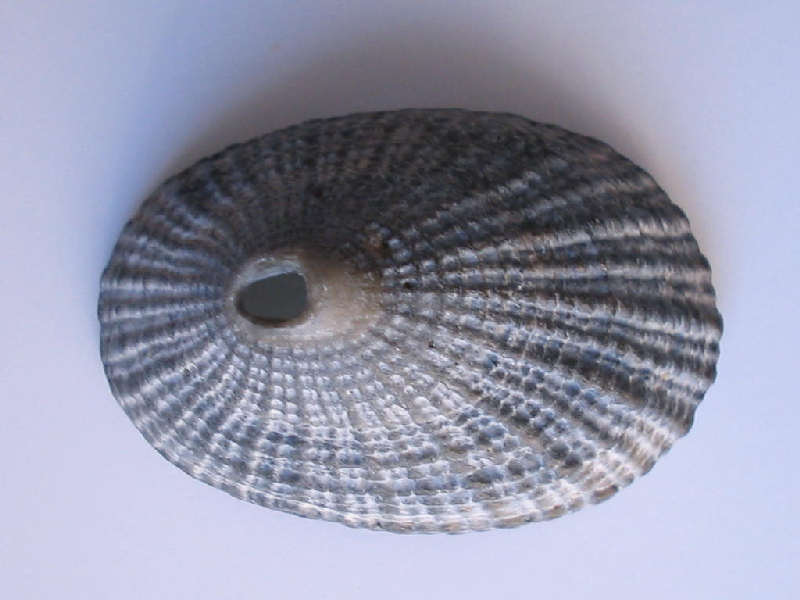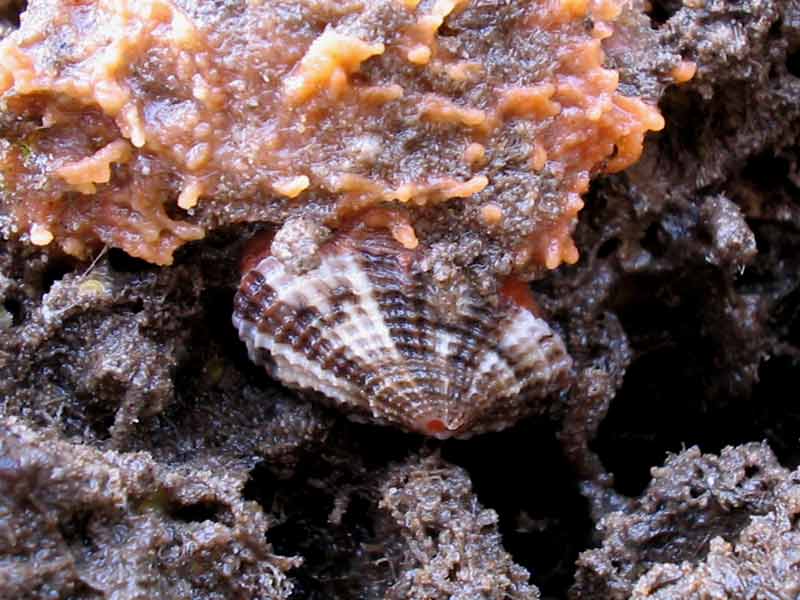Common keyhole limpet (Diodora graeca)
Distribution data supplied by the Ocean Biodiversity Information System (OBIS). To interrogate UK data visit the NBN Atlas.Map Help
| Researched by | Saskiya Richards | Refereed by | Admin |
| Authority | (Linnaeus, 1758) | ||
| Other common names | - | Synonyms | Diodora apertura |
Summary
Description
Diodora graeca has an oval-shaped, conical shell that is up to 4 cm in length. The tip of the shell bears a characteristic rounded hole, used for respiration, which is tipped forward and positioned towards the front of the shell. The surface of the shell is marked with 20-30 ridges that radiate outwards from the apex and give a convoluted appearance to the edge of the shell. In the grooves between these ridges are smaller ridges. The colour of the shell is usually white or grey but may be yellow, orange or red, and is marked with bands of brown or green radiating from the apex. The body comprises a large head, oval-shaped foot and a thick mantle. The base of the head bears two tentacles each with a lateral eye-stalk. The foot is surrounded by a ring of 30-35 well-developed tentacles that alternate between being long and short. The mantle is large enough to fall below the edge of the shell and covers the sides of the foot and bears wart-like papillae on its surface. An extension of the mantle protrudes from the apical hole forming a short, inhalant siphon. The body is coloured red, yellow, orange or white with darker spots.
Recorded distribution in Britain and Ireland
Diodora graeca is widespread on the coasts of Ireland and western Britain.Global distribution
Diodora graeca is distributed in the Mediterranean and the Canary Isles.Habitat
Diodora graeca lives on rocks and under stones in the low water zone to 250 m.Depth range
-Identifying features
- Oval-shaped, conical shell up to 4 cm long.
- Shell with 20-30 radiating ridges and rounded hole on anterior-facing apex.
- Shell marked with brown or green bands.
- Body coloured white, yellow, orange or red with dark spots.
- 30-35 alternately long and short tentacles surrounding foot.
- Wart-like papillae on surface of thick mantle.
Additional information
Diodora graeca feeds on sponges, particularly Hymeniacidon and Halichondria, by the scraping action of its radula. This species is gonochoristic and reproduces through December to May by external fertilization. The young develop in egg capsules and hatch as juveniles, hence there is no free larval stage.
Listed by
- none -
Bibliography
Campbell, A.C., 1982. The Hamlyn guide to the flora and fauna of the Mediterranean Sea. London: Hamlyn.
Costello, M.J., Bouchet, P., Boxshall, G., Emblow, C. & Vanden Berghe, E., 2004. European Register of Marine Species [On-line]. http://www.marbef.org/data/erms.php,
Graham, A., 1988. Molluscs: prosobranchs and pyramellid gastropods (2nd ed.). Leiden: E.J. Brill/Dr W. Backhuys. [Synopses of the British Fauna No. 2]
Hayward, P., Nelson-Smith, T. & Shields, C. 1996. Collins pocket guide. Sea shore of Britain and northern Europe. London: HarperCollins.
Hayward, P.J. & Ryland, J.S. (ed.) 1995b. Handbook of the marine fauna of North-West Europe. Oxford: Oxford University Press.
Howson, C.M. & Picton, B.E., 1997. The species directory of the marine fauna and flora of the British Isles and surrounding seas. Belfast: Ulster Museum. [Ulster Museum publication, no. 276.]
Picton, B.E. & Costello, M.J., 1998. BioMar biotope viewer: a guide to marine habitats, fauna and flora of Britain and Ireland. [CD-ROM] Environmental Sciences Unit, Trinity College, Dublin.
Datasets
Centre for Environmental Data and Recording, 2018. Ulster Museum Marine Surveys of Northern Ireland Coastal Waters. Occurrence dataset https://www.nmni.com/CEDaR/CEDaR-Centre-for-Environmental-Data-and-Recording.aspx accessed via NBNAtlas.org on 2018-09-25.
Conchological Society of Great Britain & Ireland, 2018. Mollusc (marine) data for Great Britain and Ireland - restricted access. Occurrence dataset: https://doi.org/10.15468/4bsawx accessed via GBIF.org on 2018-09-25.
Conchological Society of Great Britain & Ireland, 2023. Mollusc (marine) records for Great Britain and Ireland. Occurrence dataset: https://doi.org/10.15468/aurwcz accessed via GBIF.org on 2024-09-27.
Fenwick, 2018. Aphotomarine. Occurrence dataset http://www.aphotomarine.com/index.html Accessed via NBNAtlas.org on 2018-10-01
Kent Wildlife Trust, 2018. Kent Wildlife Trust Shoresearch Intertidal Survey 2004 onwards. Occurrence dataset: https://www.kentwildlifetrust.org.uk/ accessed via NBNAtlas.org on 2018-10-01.
Manx Biological Recording Partnership, 2022. Isle of Man historical wildlife records 1990 to 1994. Occurrence dataset:https://doi.org/10.15468/aru16v accessed via GBIF.org on 2024-09-27.
NBN (National Biodiversity Network) Atlas. Available from: https://www.nbnatlas.org.
OBIS (Ocean Biodiversity Information System), 2025. Global map of species distribution using gridded data. Available from: Ocean Biogeographic Information System. www.iobis.org. Accessed: 2025-07-17
South East Wales Biodiversity Records Centre, 2018. SEWBReC Molluscs (South East Wales). Occurrence dataset: https://doi.org/10.15468/jos5ga accessed via GBIF.org on 2018-10-02.
Citation
This review can be cited as:
Last Updated: 08/05/2008




